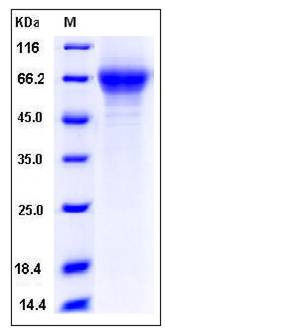Mouse THSD1 / TMTSP Protein (His Tag)
4833423O18Rik,Tmtsp
- 100ug (NPP2802) Please inquiry
| Catalog Number | P50400-M08H |
|---|---|
| Organism Species | Mouse |
| Host | Human Cells |
| Synonyms | 4833423O18Rik,Tmtsp |
| Molecular Weight | The secreted recombinant mouse THSD1 consists of 399 amino acids and has a calculated molecular mass of 45 kDa. As a result of glycosylation, the apparent molecular mass of rm THSD1 is approximately 60-70 kDa in SDS-PAGE under reducing conditions. |
| predicted N | Glu 25 |
| SDS-PAGE |  |
| Purity | > 95 % as determined by SDS-PAGE |
| Protein Construction | A DNA sequence encoding the extracellular domain of mouse THSD1 (NP_062522.1) (Met 1-Asn 412) was expressed, with a C-terminal polyhistidine tag. |
| Bio-activity | |
| Research Area | Cancer |Signal transduction |Second Messenger |Nucleotide Messenger |GTP |
| Formulation | Lyophilized from sterile PBS, pH 7.4 1. Normally 5 % - 8 % trehalose, mannitol and 0.01% Tween80 are added as protectants before lyophilization. Specific concentrations are included in the hardcopy of COA. |
| Background | Thrombospondin type-1 domain-containing protein 1, also known as transmembrane molecule with thrombospondin module, THSD1 and TMTSP, is a single-pass type I membrane protein which contains one TSP type-1 domain. THSD1 is a multi-domain, multi-functional glycoprotein synthesized by many cells. Matricellular THSD1 modulates cell adhesion and proliferation. It is involved in angiogenesis, inflammation, wound healing and cancer. In vitro, nanomolar concentrations of Thrombospondin-1 are required to alter endothelial and vascular smooth muscle cell adhesion, proliferation, motility, and survival. As a major platelet protein, for a long time it was postulated to control hemostasis via platelet aggregate stabilization. THSD1 is a potent angiogenesis inhibitor, and down-regulation of THSD1 has been suggested to alter tumor growth by modulating angiogenesis in a variety of tumor types. |
| Reference |
